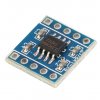DeMoNeye
Well-Known Member
Arduino, I know has built in PWM dimming, but you then need to add additional hardware to step up the PWM signal to 10V for Meanwell drivers.
Could I use a X9C104 100K digital pot instead? There's a library available and that little device gives a range of 0 to 100K ohms in 1k steps (taps). I know there are digital pots out there with a larger number of steps (taps) but 100 should be enough.

Could I use a X9C104 100K digital pot instead? There's a library available and that little device gives a range of 0 to 100K ohms in 1k steps (taps). I know there are digital pots out there with a larger number of steps (taps) but 100 should be enough.







